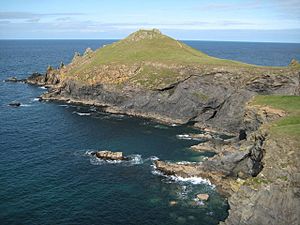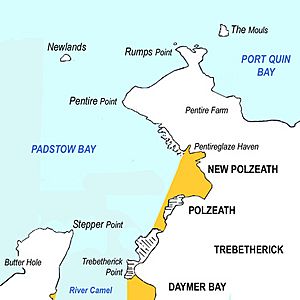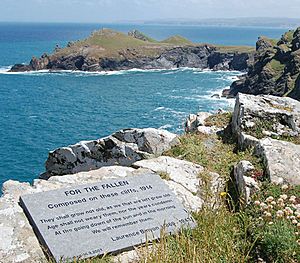The Rumps facts for kids
The Rumps is a special place in north Cornwall, United Kingdom. It's a piece of land that sticks out into the sea, with two main points. In the local Cornish language, it's called Din Pentir, which means 'fort at Pentire'.
This headland is made of very strong, dark rock called basalt. It reaches out north into the huge Atlantic Ocean. The two points of The Rumps stretch from east to west. There's a tiny island called The Mouls near the eastern point. The western point is known as Rumps Point.
You can get to The Rumps by walking along the South West Coast Path from Polzeath. Or, you can take a public footpath from the car park at Pentire Farm. The whole area, including The Rumps, is looked after by the National Trust. You can also take boat trips from Padstow to see The Rumps from the water.
An Ancient Fort at The Rumps
The Rumps was once home to an Iron Age promontory fort. This means it was a fort built on a piece of land sticking out into the sea, making it naturally easy to defend.
Archaeologists studied the fort here. They published their findings in 1974. The two headlands are connected to the mainland by a narrow strip of land. This made The Rumps a very strong place to defend.
Three large banks and ditches, called ramparts, cross the narrowest part of the land. These were built in the late Iron Age. Long ago, wooden fences likely stood on top of these earthworks. You can still clearly see these old defenses when you walk there today.
Poetry and History at The Rumps
The famous poet Laurence Binyon wrote his well-known poem, For the Fallen, in 1914. He was sitting on the cliffs between Pentire Point and The Rumps when he wrote it.
In 2001, a stone plaque was put up at this spot to remember this special event. The plaque says: For The Fallen composed on these cliffs 1914. It also includes a famous part of the poem, often called The Ode.




